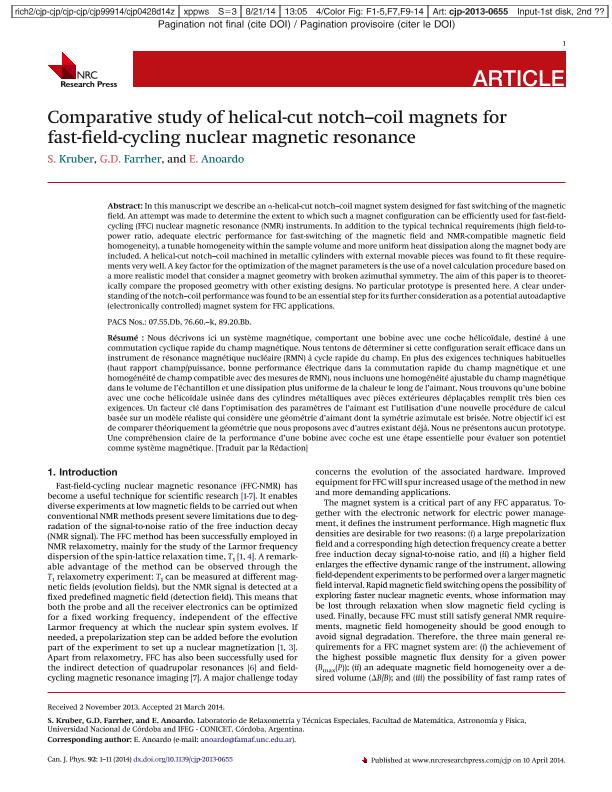Mostrar el registro sencillo del ítem
dc.contributor.author
Kruber, Stephan

dc.contributor.author
Farrher, German David

dc.contributor.author
Anoardo, Esteban

dc.date.available
2017-12-27T19:18:47Z
dc.date.issued
2014-04
dc.identifier.citation
Anoardo, Esteban; Farrher, German David; Kruber, Stephan; Comparative study of helical-cut notch–coil magnets for fast-field-cycling nuclear magnetic resonance; National Research Council Canada-NRC Research Press; Canadian Journal Of Physics; 92; 11; 4-2014; 1430-1440
dc.identifier.issn
0008-4204
dc.identifier.uri
http://hdl.handle.net/11336/31700
dc.description.abstract
In this manuscript we describe an -helical-cut notch–coil magnet system designed for fast switching of the magneticfield. An attempt was made to determine the extent to which such a magnet configuration can be efficiently used for fast-field-cycling (FFC) nuclear magnetic resonance (NMR) instruments. In addition to the typical technical requirements (high field-to-power ratio, adequate electric performance for fast-switching of the magnetic field and NMR-compatible magnetic fieldhomogeneity), a tunable homogeneity within the sample volume and more uniform heat dissipation along the magnet body areincluded. A helical-cut notch–coil machined in metallic cylinders with external movable pieces was found to fit these require-ments very well. A key factor for the optimization of the magnet parameters is the use of a novel calculation procedure based ona more realistic model that consider a magnet geometry with broken azimuthal symmetry. The aim of this paper is to theoret-ically compare the proposed geometry with other existing designs. No particular prototype is presented here. A clear under-standing of the notch–coil performance was found to be an essential step for its further consideration as a potential autoadaptive(electronically controlled) magnet system for FFC applications.
dc.description.abstract
Nous décrivons ici un système magnétique, comportant une bobine avec une coche hélicoïdale, destiné a`unecommutation cyclique rapide du champ magnétique. Nous tentons de déterminer si cette configuration serait efficace dans uninstrument de résonance magnétique nucléaire (RMN) a`cycle rapide du champ. En plus des exigences techniques habituelles(haut rapport champ/puissance, bonne performance électrique dans la commutation rapide du champ magnétique et unehomogénéité de champ compatible avec des mesures de RMN), nous incluons une homogénéité ajustable du champ magnétiquedans le volume de l’échantillon et une dissipation plus uniforme de la chaleur le long de l’aimant. Nous trouvons qu’une bobineavec une coche hélicoïdale usinée dans des cylindres métalliques avec pièces extérieures déplaçables remplit très bien cesexigences. Un facteur clé dans l’optimisation des paramètres de l’aimant est l’utilisation d’une nouvelle procédure de calculbasée sur un modèle réaliste qui considère une géométrie d’aimant dont la symétrie azimutale est brisée. Notre objectif ici estde comparer théoriquement la géométrie que nous proposons avec d’autres existant déja`. Nous ne présentons aucun prototype.Une compréhension claire de la performance d’une bobine avec coche est une étape essentielle pour évaluer son potentielcomme système magnétique.
dc.format
application/pdf
dc.language.iso
eng
dc.publisher
National Research Council Canada-NRC Research Press

dc.rights
info:eu-repo/semantics/openAccess
dc.rights.uri
https://creativecommons.org/licenses/by-nc-sa/2.5/ar/
dc.subject
Ffc - Nmr
dc.subject
Magnet Systems
dc.subject
Homogeneity
dc.subject
Optimization
dc.subject.classification
Astronomía

dc.subject.classification
Ciencias Físicas

dc.subject.classification
CIENCIAS NATURALES Y EXACTAS

dc.title
Comparative study of helical-cut notch–coil magnets for fast-field-cycling nuclear magnetic resonance
dc.type
info:eu-repo/semantics/article
dc.type
info:ar-repo/semantics/artículo
dc.type
info:eu-repo/semantics/publishedVersion
dc.date.updated
2017-12-26T20:39:01Z
dc.journal.volume
92
dc.journal.number
11
dc.journal.pagination
1430-1440
dc.journal.pais
Canadá

dc.journal.ciudad
Otawa
dc.description.fil
Fil: Kruber, Stephan. Consejo Nacional de Investigaciones Científicas y Técnicas. Centro Científico Tecnológico Conicet - Córdoba. Instituto de Física Enrique Gaviola. Universidad Nacional de Córdoba. Instituto de Física Enrique Gaviola; Argentina
dc.description.fil
Fil: Farrher, German David. Consejo Nacional de Investigaciones Científicas y Técnicas. Centro Científico Tecnológico Conicet - Córdoba. Instituto de Física Enrique Gaviola. Universidad Nacional de Córdoba. Instituto de Física Enrique Gaviola; Argentina
dc.description.fil
Fil: Anoardo, Esteban. Consejo Nacional de Investigaciones Científicas y Técnicas. Centro Científico Tecnológico Conicet - Córdoba. Instituto de Física Enrique Gaviola. Universidad Nacional de Córdoba. Instituto de Física Enrique Gaviola; Argentina
dc.journal.title
Canadian Journal Of Physics

dc.relation.alternativeid
info:eu-repo/semantics/altIdentifier/doi/http://dx.doi.org/10.1139/cjp-2013-0655
dc.relation.alternativeid
info:eu-repo/semantics/altIdentifier/url/http://www.nrcresearchpress.com/doi/10.1139/cjp-2013-0655
Archivos asociados
